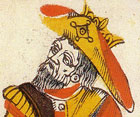The names used by Master card-makers
Marseille tarots of the 17th and 18th centuries
Jacques Viéville, Jean Noblet, Jean Dodal,
Jean-Pierre Payen, Nicolas Conver
It becomes evident, as you study master tarot-makers, that they worked under assumed names drawn from the ancient western traditions of “jean” and “jacques”: The people (in French : gens, hence jean) of towns and those (jacques) of the countryside.
Two traditions were at the source of the knowledge transmitted by the tarot. One was the that of the image-makers, designers of stained-glass windows and sculptors of capitals, from which originated tarots which we today call “of Marseille” and which wasprobably born in Milan. The other, tradition of the architects and masons, is sometimes classed as being in the Piémontaise or Bologne tradition.
At the heart of these traditions lay the knowledge signposting the “journey of the soul”. That they differ in image content merely indicates that these two groups did not share the same mental environment. An image doesn’t speak in the same way to a mason as to an artist. To transmit, through images, this “life’s way” or journey of the soul, one had to adapt to one’s public.
And the public of the countryside is not the same as that of the towns. Rural workers and artisans were not lettered city dwellers.
Jacques, from the countryside tradition, Viéville, the old man who lives in town. The old country dweller who lives in the city.
Through the name he assumes, Jacques Viéville indicates the tradition he came from and the probability that he was a source of rural-based knowledge.
Jean Noblet, also a Parisian, a city dweller, serving a noble clientele in an elegant quarter of the town.
As for Jean Dodal in early 18th century Lyon, the first name Jean places him in the image-makers’ tradition. Dodal, on the other hand, may actually be his true family name.
Jean(-Pierre) Payen (Payen is french for Pagan) in Avignon, also early 18th century, doesn’t beat about the bush: “I am a secular image-maker” he says. “What I transmit is not religion.”
Nicolas Conver is probably the last historic transmittor of the tarot. The name Nicolas immediately suggests a Germanic or Alsatian origin. “Conver” is of course a convert. Nicolas Conver was probably a Jew who emigrated from Germany. Once installed in France, he didn’t take on a traditional assumed name, perhaps through ignorance. He more likely didn’t use one because, by his time (mid 18th century), direct transmission from master to compagnon was a thing of the past.
We can take 1717 as signpost, year when the first Masonic Lodge using the Scottish rite was established. A year which marks the end of transmission of traditional knowledge, and a radical change in mentality. We pass from “operative” (the Freemason knew how to build a wall) to “speculative” (he could only talk about it) Freemasonry.
It was just at this time that the last cagot builders of south-western France disappeared, the last “witch” was burned to death on the town square, chemistry replaced alchemy, and the last scraps of Medieval sacred knowledge sank into the dusty night of time.

